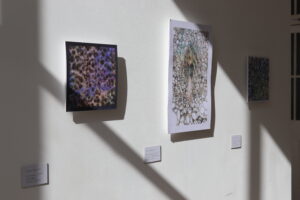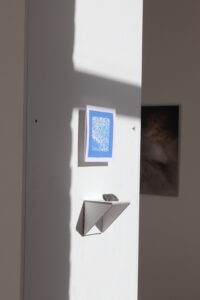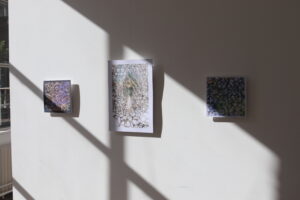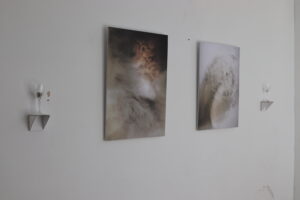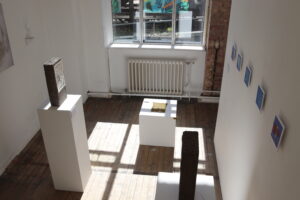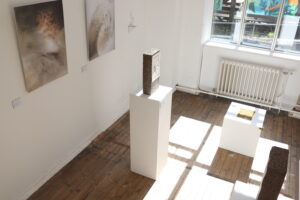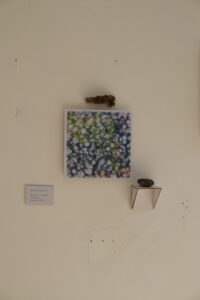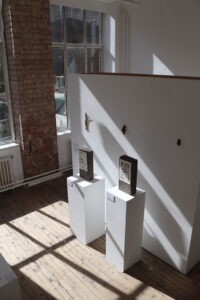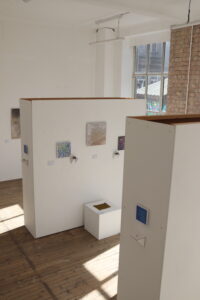Week 12: Practical Research – Mycorrhizal Exhibition and Reflection
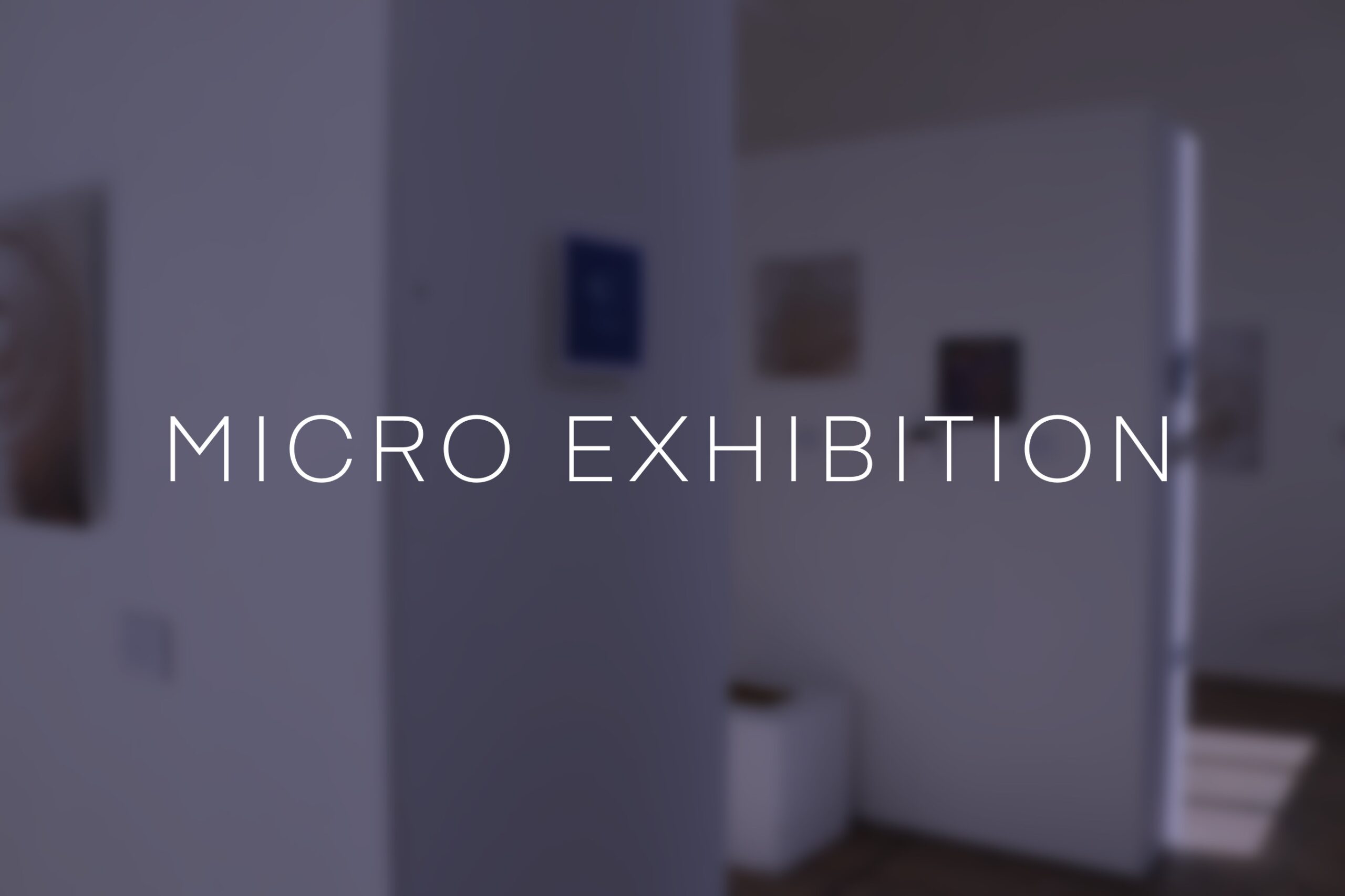
Set Up:
I arrived at the In Vitro gallery at 9:00am and helped Layla Knox move her sculptural work out of her car and into the building. I removed all the tables and chairs from the space, keeping only a few in the gallery space to use as a workstation and to have easy access to stools. I went over my exhibition plans with Knox, who also co-installed the art alongside me, as hers was the only piece that I had not had a chance to look at in person, whereas I had been able to get a sense of scale and tactile knowledge of the other work as I personally printed and mounted it. With my exhibition design agreed on, Knox offered installation and advice surrounding the aesthetic arrangement of the work, which I think benefitted the overall result greatly.
Exhibition Layout 1
We started in the central area of the gallery. Using silicone glue dots, Knox installed Nettle Weaving, Lichen, and Untitled Crochet on the right-hand wall. Originally, I had anticipated that the plinths that would hold Chapel Painting I and Chapel Painting II would be in the centre of the room facing away from each other (Figure 1), but with critical observation, the plinths were rearranged to be closer to the wall (Figure 2). The new arrangement aligned closely with the original display that the artist intended, while the spatial display made the pieces feel more united. Knox’s work took on a directionality with all the pieces facing the wall opposite. Though this arrangement benefitted Knox’s display, I was concerned that the directionality may imply an oppositional narrative.
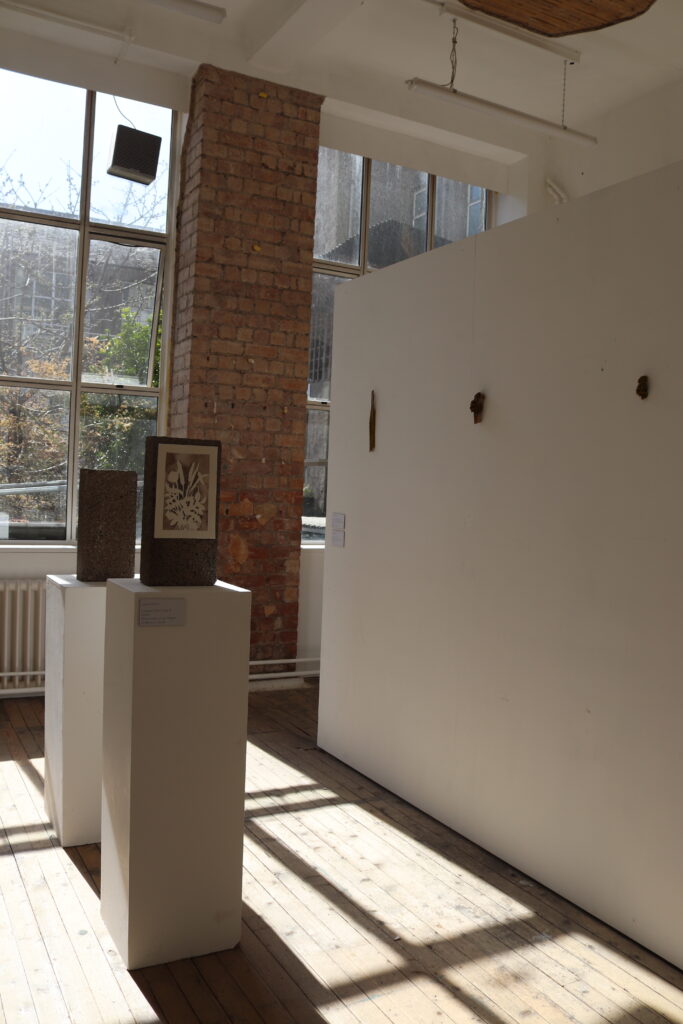
Figure 1, Mycorrhizal Exhibition View including: Layla Knox, Nettle Weaving (Wall Left) (2025), Lichen (Wall Middle) (2025), Untitled Crochet (Wall Right) (2025), Chapel Painting I (Plinth Front) (2025), and Chapel Painting II (Plinth Back)(2025), In Vitro Gallery, Summerhall, Photographed By Harry Mayston (06/04/25)
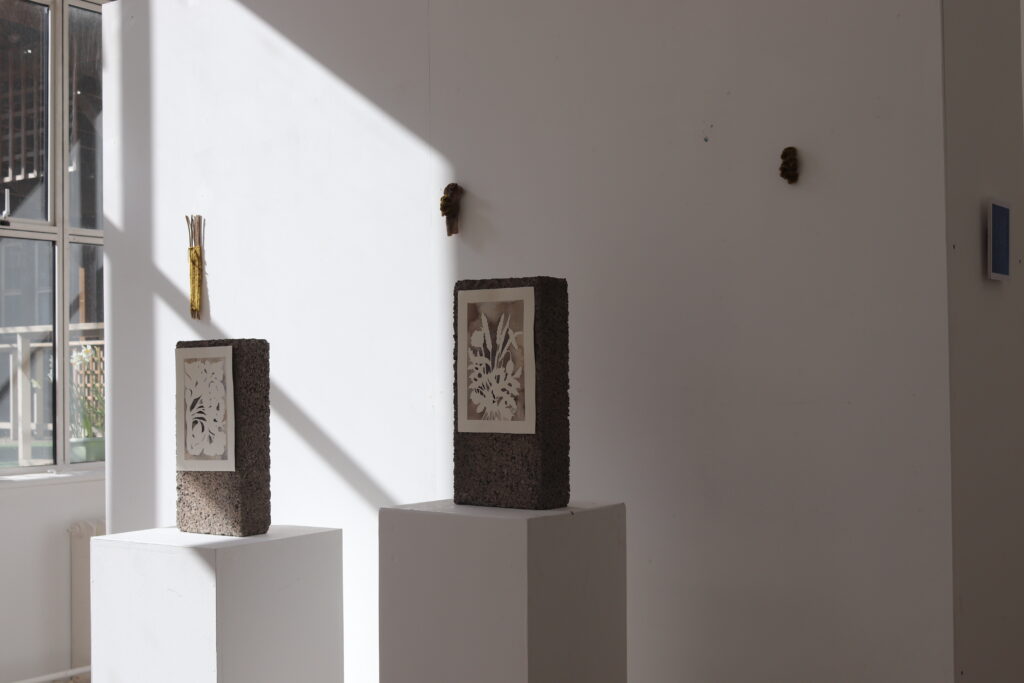
Figure 2, Mycorrhizal Exhibition View including: Layla Knox, Nettle Weaving (Wall Left) (2025), Lichen (Wall Middle) (2025), Untitled Crochet (Wall Right) (2025), Chapel Painting I (Plinth Right) (2025), and Chapel Painting II (Plinth Left)(2025), In Vitro Gallery, Summerhall, Photographed By Harry Mayston (06/04/25)
I placed the rest of the large pieces, like Stop me From Plummeting and Untitled by Romy Antrobus, and Hierophany by myself, in the space before arranging the smaller pieces. I had anticipated that Monuments would pose a particular challenge as they were intended to be arranged throughout the gallery space; however, I found that the components of the piece, comprised of individual collected stones displayed on shelves (Figure 3.), formed constructive aesthetic and thematic connections. I think that the shelves that the found stones were positioned on made them look like an offering, reaching out into the three-dimensional space at a height accessible to reach out and pick up. The materiality of stones near Antrobus’s work created an association of throwing rocks in water, activating the viewer via association with self-referential experience. The heightened awareness of their own actions reinforced themes of cause and effect in Antrobus’s work and emphasised the exhibition goal, making an audience more aware of the interconnectivity of their actions. Additionally, an aesthetic dialogue emerged between the breezeblocks, used to mount Chapel Painting I and Chapel Painting II, leading the viewer to re-examine the taming of the lithic into a man-made rock.
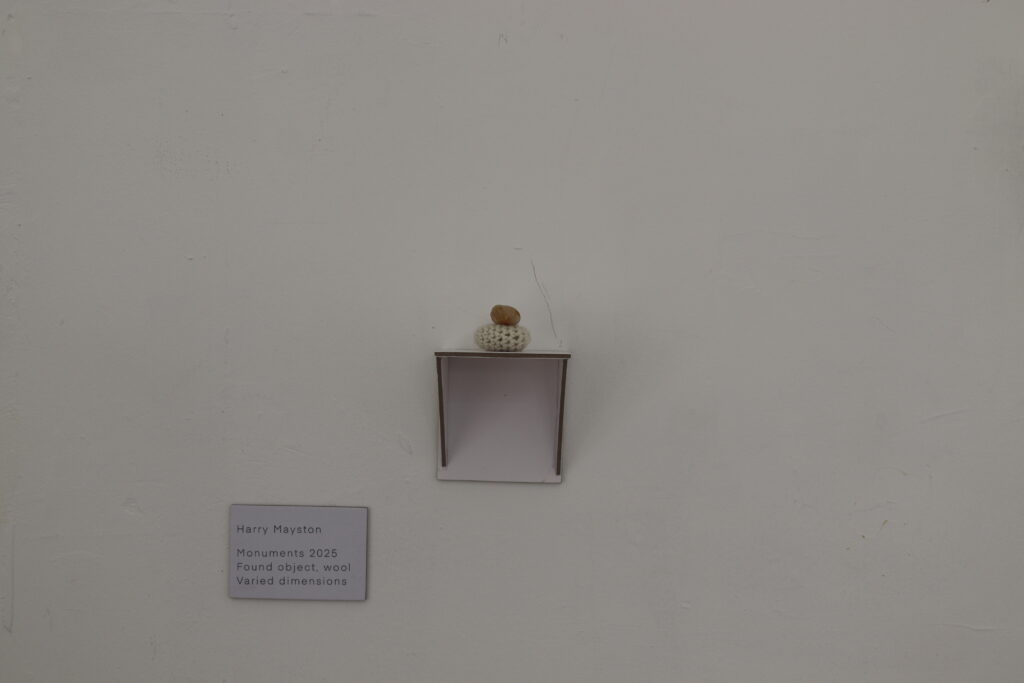
Figure 3. Harry Mayston, Monuments (2025), Found Object, In Vitro Gallery, Summerhall, Photographed by Harry Mayston (06/04/25)
After installing all the work for this iteration of layout, I decided that the left-hand wall of the centre space needed to be changed (Figure 4). The directionality of Knox’s work overwhelmed the minimalist display and diminished the standing of the pieces of individual works of art and their inherent value. In response, I focused only on this central space, assessing what components I found to be successful and what needed to be changed. The two components of Monuments were effective, mirroring the breezeblocks in colour and material, while the curation of the space gave the impression of them both reaching out from the wall and into the three-dimensional space of the gallery. I decided to incorporate an arrangement of my Layout 2, Bringing Hollows I and Hollows II onto the wall, while retaining Monuments and moving Doily onto a lower plinth (Figure 5). I believe that this was more aesthetically effective and developed a more thematically complex central area of the gallery.
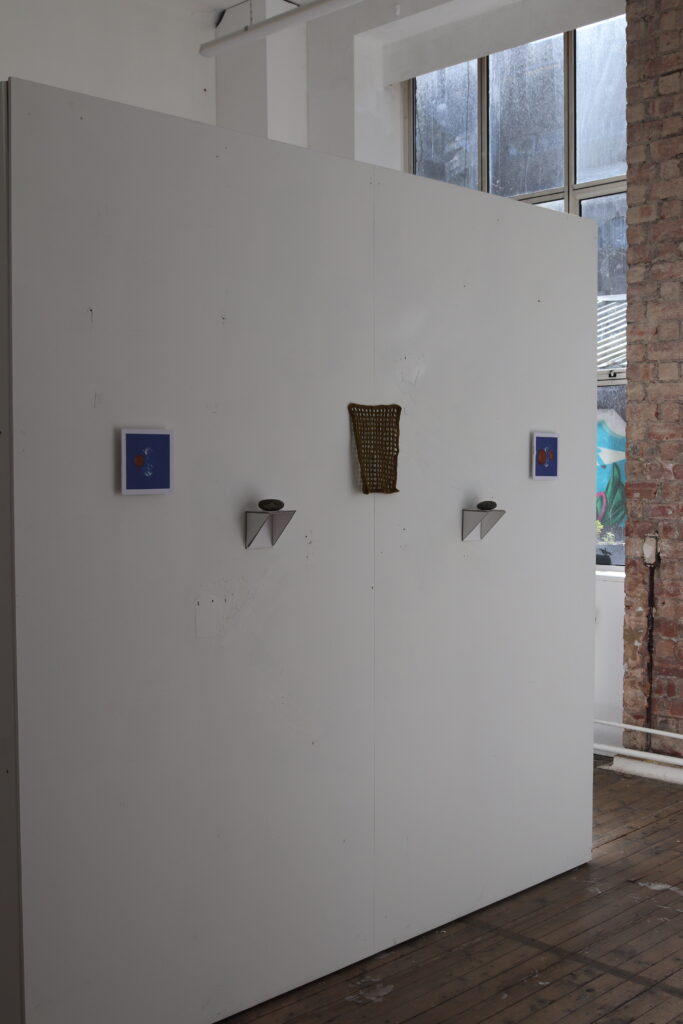
Figure 4. Exhibition View featuring, Harry Mayston Darned (2025) (Wall: Left, and right) (2025), Harry Mayston Monuments (shelves)(2025), and Layla Knox Doily (centre) (2025), In Vitro gallery, Summerhall, Photographed by Harry Mayston (06/04/25)
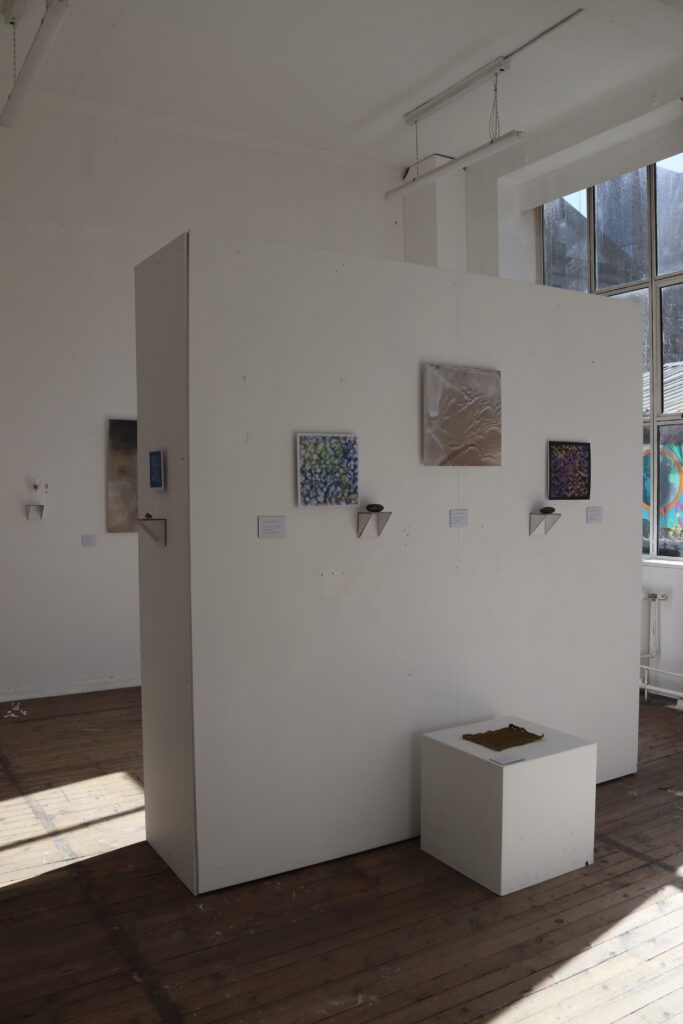
Figure 5. Exhibition View featuring, Harry Mayston Hollows I (2024) (Wall Left), Harry Mayston Hollows II (Wall Right) Monuments (shelves)(2025), Layla Knox Doily (Plinth) (2025), Romy Antrobus Whispered (2024) (Wall Centre) In Vitro gallery, Summerhall, Photographed by Harry Mayston (06/04/25)
Exhibition Layout 2
The intention of this layout was to put the work of all three artists close together in the first two spaces. The last space (the one furthest to the right upon entry) suited a minimalist design, being the area that leads to an office space as well as being the smallest and only contained one artist’s work (figure 6).
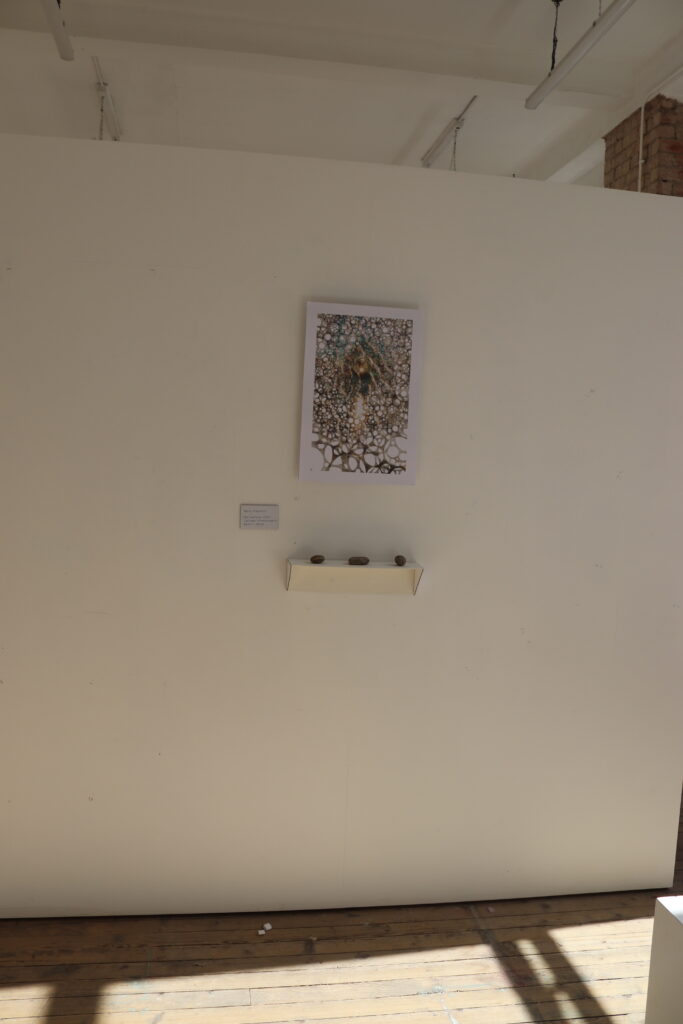
Figure 6. Exhibition View Featuring: Harry Mayston Heirophany (Wall)(2025), and Harry Mayston Monuments (Shelf) (2025), In Vitro Gallery, Summerhall, Photographed By Harry Mayston (06.04.25)
The left space contained Layla Knox’s Chapel Painting I, Chapel Painting II, and Lichen; Mayston’s (My) Blue Things; and Darned; and retained Antrobus’s Stop me from Plummeting and Untitled from the previous curation (Figure 7 & figure 8). I believe by having more than just one piece from each artist and ensuring that the work is aesthetically distinguishable from the other artists, the space can blend cultural and theoretical themes and contexts whilst maintaining artist recognisability and promoting the value of the individual arts within a friction-centred narrative. Though it was not my intention to specifically develop a narrative tension within this version of the exhibition, instead leaving meaning making solely to the perceptions of the viewer, I noticed that the pieces were united by the materiality of water, emerging in the process of cyanotype, watercolour, and analogue water photography.
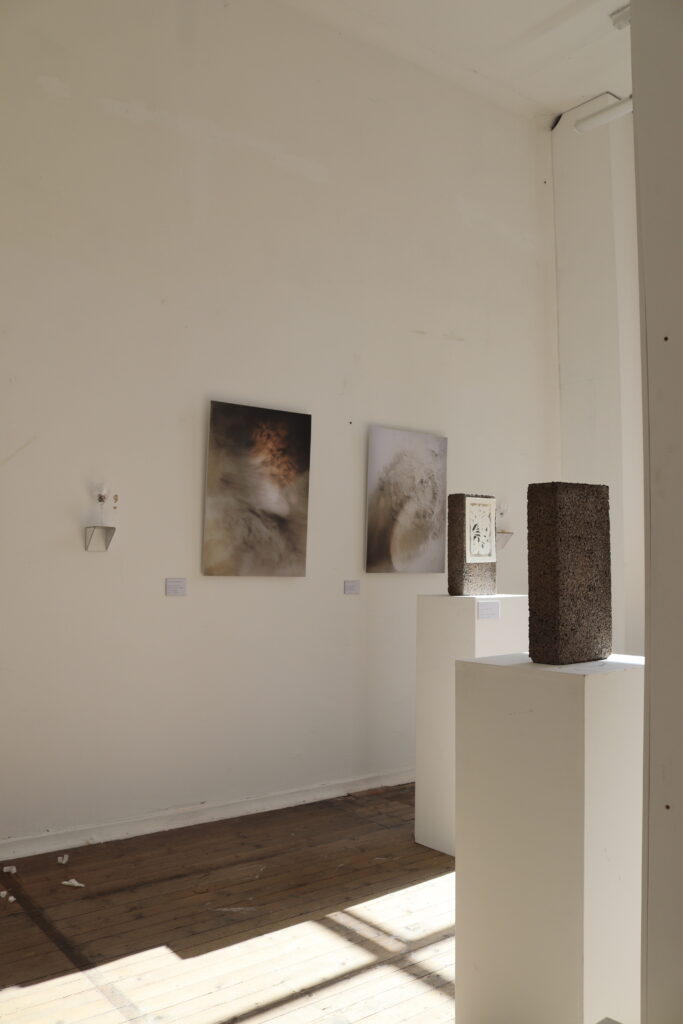
Figure 7. Exhibition View featuring, Layla Knox Chapel Painting I (Plinth facing away)(2025), Layla Knox Chapel Painting II, (Plinth facing forward) (2025), Harry Mayston Monuments (shelves)(2025), Romy Antrobus Stop me from Plummeting (Wall Left) (2025), Romy Antrobus Untitled (Wall Right) (2025), In Vitro gallery, Summerhall, Photographed by Harry Mayston (06/04/25)
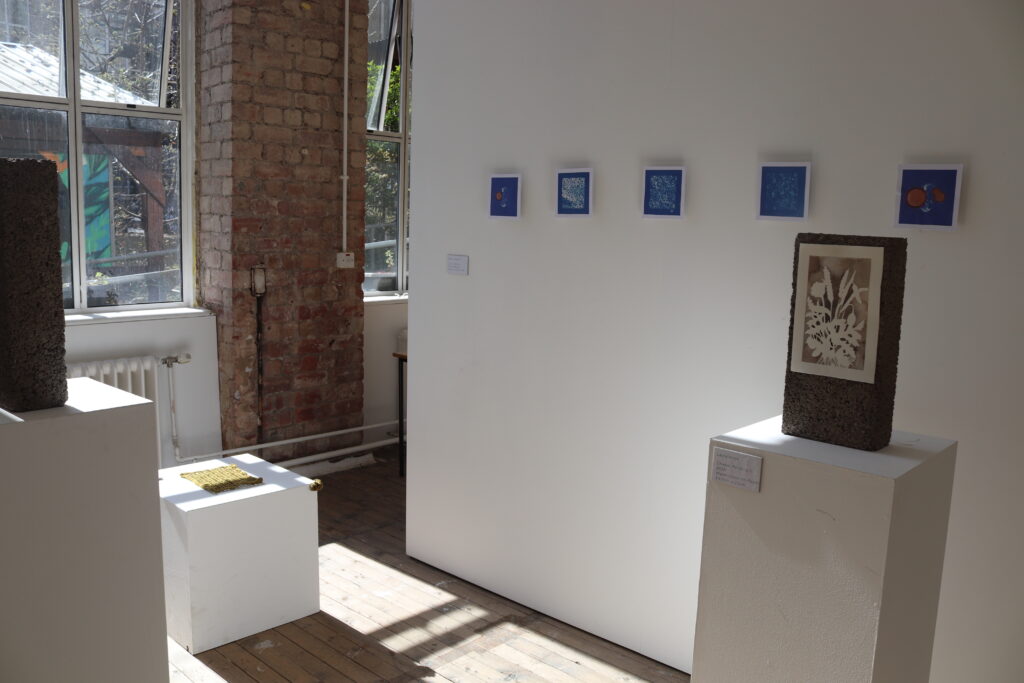
Figure 7. Exhibition View featuring, Layla Knox Chapel Painting I (Plinth facing forward)(2025), Layla Knox Chapel Painting II, (Plinth facing away) (2025), Layla Knox Doily (Low Plinth) (2025), Harry Mayston Blue things (Wall) (2025), In Vitro gallery, Summerhall, Photographed by Harry Mayston (06/04/25)
Application to Individual Project:
This experience has provided me with valuable experience in anticipating the ways that a viewer will interact with arrangements of artwork, as well as shown me that a curator must remain responsive to material relationships as they emerge. Though I had designed aspects of the layouts with specific intentions and connections, the process of using water in image generation in Layout 2 only became apparent when the work was installed and visualised on location. This has caused me to consider how the artwork will be arranged within the Strange Field space. Though a floor plan map has been beneficial in strategically placing pieces and thinking about the movement of audiences throughout the gallery, I believe that having a three-dimensional knowledge of how art will appear will help me thoroughly consider how artists practices can create constructive associations and enhanced awareness of exhibition themes. I will develop a three-dimensional rendering of the Strange Field warehouse gallery.
The display of small pieces of Monuments throughout the space was also a challenging task, but I think that it offered an aesthetic continuity to the space whilst supporting the conceptual meaning of the piece as a Hyperobject. As I had used gallery labels throughout the space, I was concerned with how I would label small pieces, but I discovered that by having only one of the components labelled and then using the same distinctive shelf exclusively for the other found objects that make up the piece, I could subtly signal to an audience that they are all part of one piece or all attributed to the same artist. I believe that I may be able to continue this in my speculative project, even using display methods like small podiums to create a hierarchy of visual motifs that subtly attribute the art to a specific artist within the exhibition.
Lastly, I learnt about the value of incorporating artists’ values and considerations when developing a gallery arrangement. The input of Layla Knox whilst installing was invaluable and, I believe, aided in constructing a conscientiously formed exhibition. Though I would not anticipate all artists to be physically present for the installation of Weird Frictions, I will include in my schedule time to discuss the curatorial display with the artist involved to attain their input and include paid discussion time in my budget.
Additional Exhibition Photos
